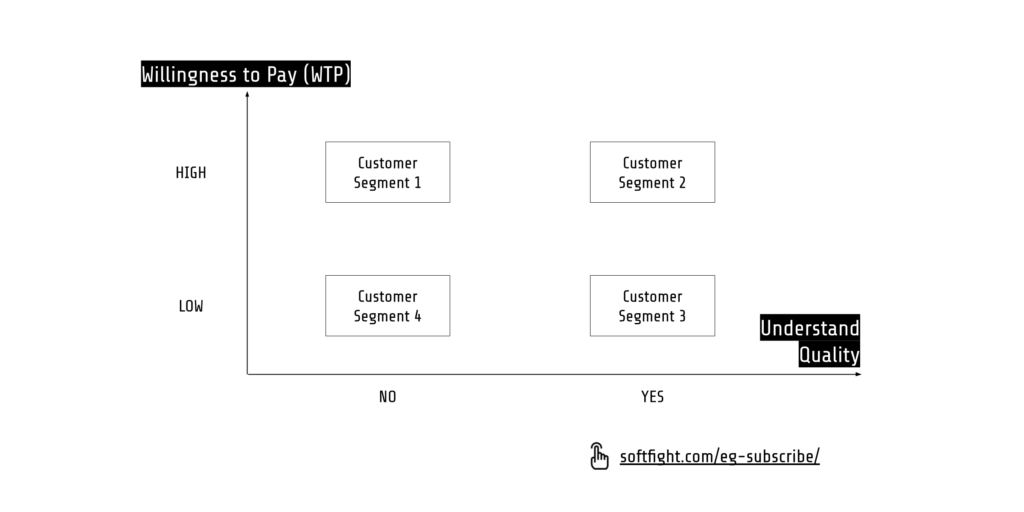Choosing your customer segments is a critical step on the road to optimum prices and increased revenues.
There are tens of variables that you could evaluate and use when choosing your customer segments.
Two of these variables have a significant impact in the buying process for software services:
- willingness to pay
- to what degree your customers understand quality for the services you are offering.
In any strategy exercise it is useful to think about your customers in these terms and choose your customer segments carefully, based on your business objectives.

You can evaluate an organisation as a whole, a group of people involved in the buying process or an individual that acts as the main buyer.
For the sake of simplicity, I will refer to the buyer as an individual.
Segment 1: High WTP. Doesn’t understand quality
Example: VP in a business role for a large multinational company, buying software services to develop an internal tool.
This could go either way.
You could be successful in getting the project at higher prices if you manage to identify correctly their main buying decision criteria and convince them you are the right partner.
Or you could lose the project on price to a lower-cost vendor, that will make a complete mess of the project. As the buyer doesn’t have the competence to evaluate the relationship between quality and price, your best chance is to try to educate them and hope they learn quickly.
Segment 2: High WTP. Understands quality
Example: The CTO of a profitable, medium-sized software company in healthcare, looking to extend their platform with new capabilities.
The good: This would be a great client if you get to work with them. And once you are in, there are good chances of it turning into a long-term collaboration, as long as you deliver the quality they need.
The bad: There is probably a lot of competition for the project.
The ugly: You might have to work with very low margins. Both because you need to give a competitive price and because you will probably have to spend more over time to deliver the high quality needed.
Segment 3: Low WTP. Understands quality
Example: A researcher in computer science academia looking to create a product based on the results of some laboratory experiments.
You might want to take on some projects for your own learning experience or for some other non-financial reasons (portfolio, working with a new technology, etc.).
Segment 4: Low WTP. Doesn’t understand quality
Example: Founder of a tech startup, just graduated university with a business degree, has no experience of building software
If you are a team of developers doing high quality work, it might prove difficult to convince such a client to pay the rates you are charging.
What can you do: start with a very small, fixed-scope, fixed-price project, developing something that will help the startup get some funding from investors (a proof of concept, clickable prototype or anything similar). If the founder manages to get funding based on your work, you are in a much better position:
- He can afford to pay a higher price for your services
- There is a higher chance that trust is now built into your relationship, so that you can have a say in terms of process, technology stack, architecture, to compensate for the client’s lack of experience in building software
WHAT THIS MEANS FOR YOU
Here is a simple exercise you can do on your own or together with your team: take the list of all your existing customers and place them on this matrix.
See what you learn from this.
There might be some things you can change for the better in your strategy or sales process.
